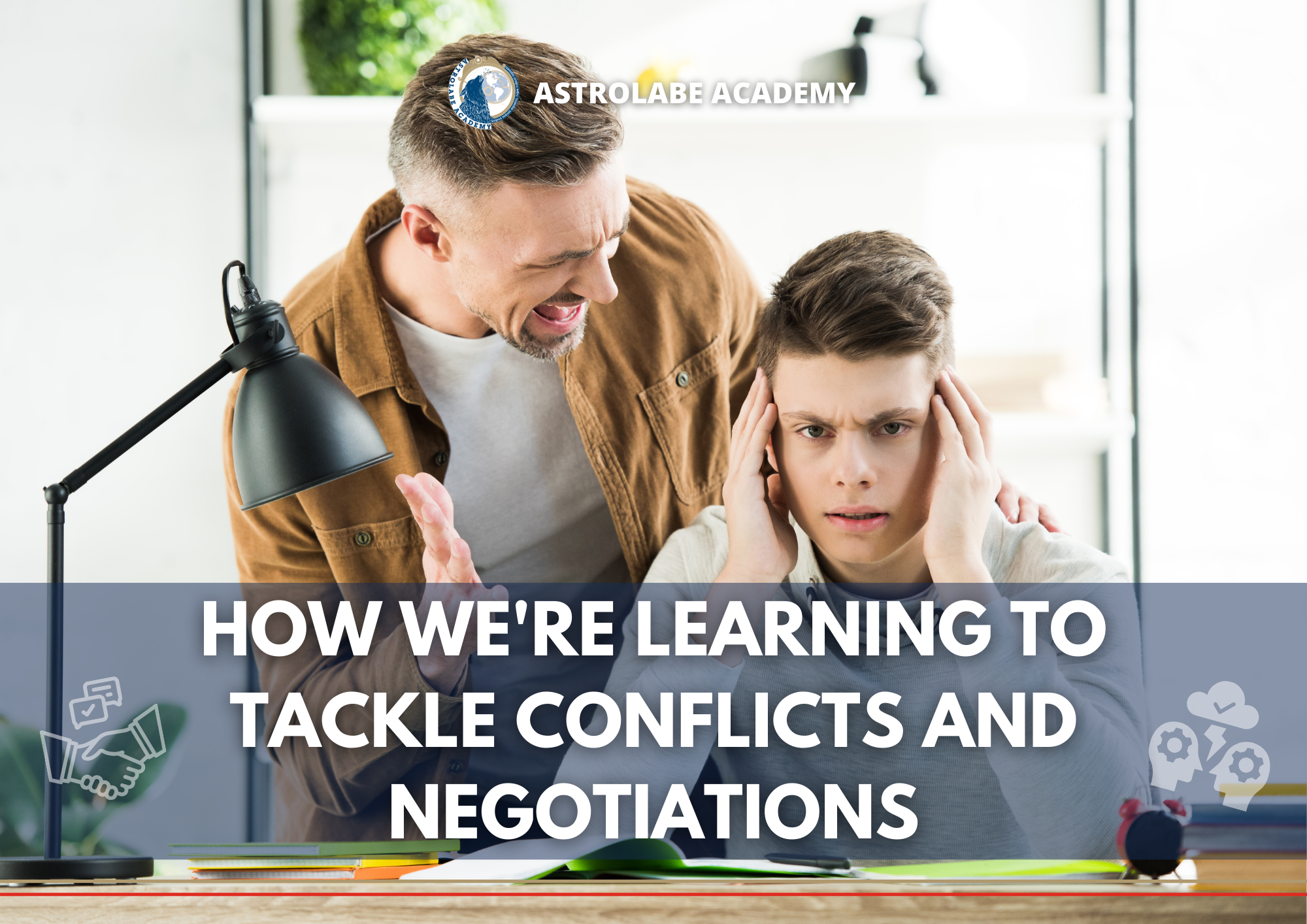Blog
Conflicts & Negotiations
How We’re Learning to Tackle Conflicts and Negotiations
Just wrapped up an enlightening session on conflict resolution and negotiation skills, focusing on some key strategies that are not just about getting through to the other side of a disagreement but also about growing as individuals. The teens dove into the nuances of negotiation with enthusiasm, sharing their experiences and trying out new approaches.
Breaking It Down: Conflict and Negotiation
First off, we laid the groundwork by chatting about what conflict resolution and negotiation mean in everyday language. Conflict resolution is figuring out how to cool down a hot situation without anyone losing their cool. And negotiation? It’s about talking things through to get to a place where everyone feels like they’ve won something.
Here’s a closer look at the core elements we explored:
1. Preparation and Research
We kicked off by discussing how crucial it is to come prepared. It’s not just about knowing what you want but also understanding where the other person is coming from. For instance, a teen wanting a later curfew might first consider their parents’ worries about safety and responsibility, preparing a reasoned argument that addresses these concerns.
2. Active Listening
Active listening turned out to be a game-changer for many. It’s about really hearing what the other person has to say, which can totally shift the direction of a negotiation. Like when you’re figuring out who does what in a group project, and everyone feels heard.
3. Effective Communication
We then navigated through the importance of clear and assertive communication. It’s about expressing your needs while being open to others’ perspectives, kind of like negotiating chores with a sibling and explaining why sharing the load is fair.
4. Empathy and Perspective-Taking
Seeing things from the other person’s point of view can make a world of difference. Whether it’s understanding a teacher’s decision or why your parents set certain rules, empathy bridges gaps.
5. Finding Common Ground
Finding common ground was all about identifying shared interests that can lead to win-win outcomes. This could look like siblings agreeing on a chore schedule that suits them both, aiming for a peaceful coexistence.
6. Problem-Solving Approach
Approaching negotiations as a joint problem-solving effort, rather than a battle to be won, fosters collaboration. A practical example is resolving computer time conflicts by creating a schedule that works for everyone involved.
7. Use of “I” Statements
We practiced framing our needs and feelings with “I” statements to avoid blame and encourage open dialogue. It’s the difference between saying “You never listen” and “I feel overlooked.”
8. Compromise and Flexibility
Learning to bend without breaking was a key lesson. Compromise doesn’t mean giving up; it means adjusting. Like negotiating an extra chore in exchange for more freedom on weekends.
9. Setting Clear Goals
Having a clear idea of what you’re aiming for in a negotiation helps steer the conversation. Teens discussed setting specific goals, like negotiating for certain privileges with clear justifications.
10. Maintaining Relationships
Above all, we emphasized the importance of preserving relationships beyond the negotiation table. It’s about ensuring everyone feels respected and valued, regardless of the outcome.
Through engaging discussions and imagined scenarios, our students not only grasped these concepts but also leaned to apply them. Whether it was negotiating curfew extensions or balancing group project roles, they demonstrated growth, understanding, and a newfound appreciation for the art of negotiation.
The diversity in their backgrounds brought rich perspectives to the table, highlighting how different family dynamics influence negotiation styles. It was particularly insightful to hear from one student who tends to withdraw in conflicts, contrasting with another who feels comfortable navigating disagreements at home. These discussions underscored the importance of adapting our approaches based on our experiences and the situation at hand.
The session was a reminder that negotiation and conflict resolution are skills that can be developed and refined over time. By focusing on preparation, empathy, effective communication, and maintaining relationships, our teens are well on their way to becoming adept negotiators in both their personal and future professional lives.
What We Noticed
It was clear that how we’re raised plays a big role in how we handle conflict and negotiation. The mix of parenting styles in the room meant everyone had a different starting point, which made for some rich discussions.
Wrapping Up
Everyone left with a new tool or two in their belt for handling conflicts and negotiating better outcomes. It was a reminder that getting good at this stuff can really make life smoother, whether you’re dealing with family, friends, or someday, co-workers.
Can’t wait for the next session to build on what we’ve started here. And hey, practicing these skills in real life? That’s the homework. Let’s see how it goes!
————————————————————————————–
Join the Conversation
As we continue to navigate the complexities of communication and relationships, the lessons learned in this session are just the beginning. We’d love to keep this conversation going in our FB group and hear more about your experiences and strategies in conflict resolution and negotiation. Whether you’re a teen eager to share your own journey, a parent observing growth in your child, or an educator looking for innovative teaching methods, your insights enrich our collective understanding. Join us in this ongoing dialogue by sharing your stories and tips in the comments below or on our social media platforms. Together, we can build a community of thoughtful communicators, ready to tackle life’s challenges with confidence and empathy.
--------------------------
Join the discussion about this and other high school education topics in our Facebook Group "Alternatives to High School". The goal of the group is to give parents a place to discuss options to public/private school and standardized curriculum as well as share resources for educating teens.
EDCHAT SERIES
Busting the Myths of Education
Part 1: Self Directed Education
Part 3: Myth Busting-Traditional High School Education is the Only Path to Success
Part 4: Myth Busting-Alternative Education and the Fear of "Gaps"
Part 5: Myth Busting-Do Self-Directed Learners Miss Out on Learning Scheduling & Prioritization?
Part 6: Myth Busting-Learning to Sit Still & Focus
Part 7: Myth Busting-Becoming Well-Rounded Outside Traditional Education
Part 8: Myth Busting-They Won't Have Study Stamina
Part 9: Myth Busting-Beyond Traditional Curriculum
Part 10: Rethinking the "Necessities" of Education
Part 11: Preparing for College Beyond Traditional High School
Part 12: Building Bridges – Reconnecting with Your Teen
Part 13: Navigating Your Teen's Educational Journey
Part 14: Unveiling Emotoional Intelligence: A Deep Dive With Asttrolabe Academy's Teens
Part 15: Unleashing Creativity: A Reflection on Our Latest Interactive Session
__________________
Busting the Myths
Want to deep dive into this topic? Contact us to request a full day in-person seminar in your area!
By appointment
By Email:
info@astrolabeacademy.com
Non-Discrimination Policy
Astrolabe Academy welcomes all students regardless of race, religion, color, gender, nationality or ethnic origin.

